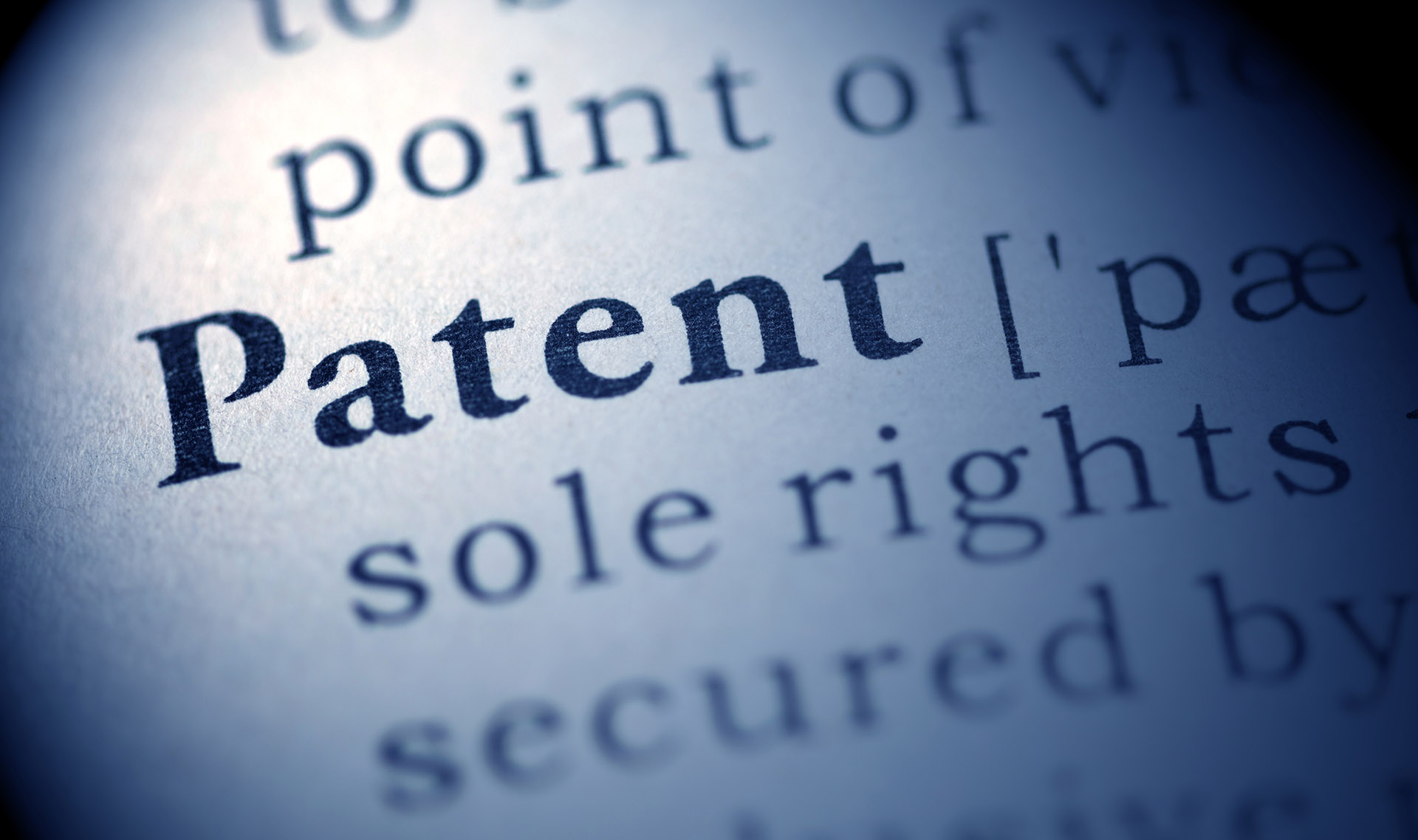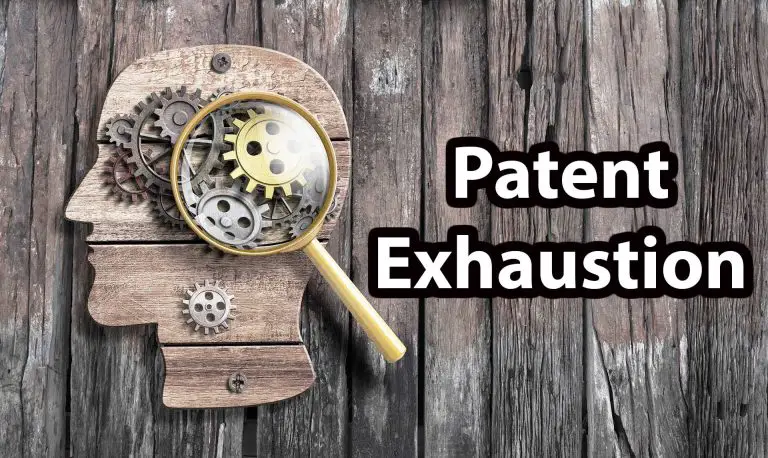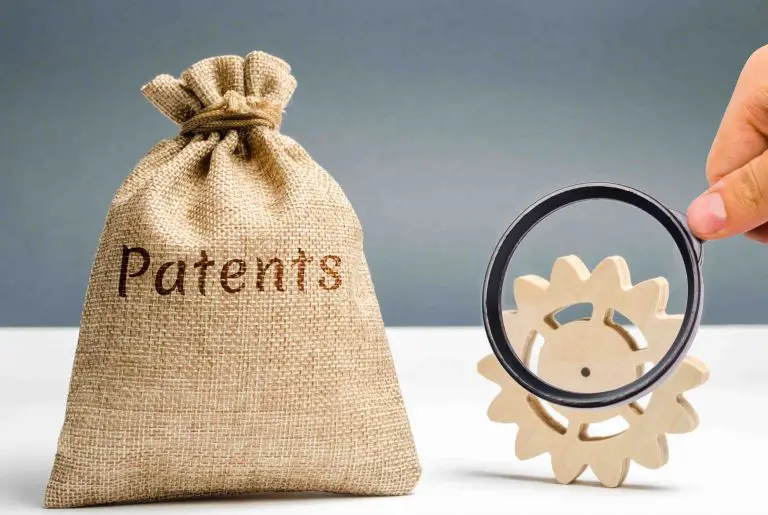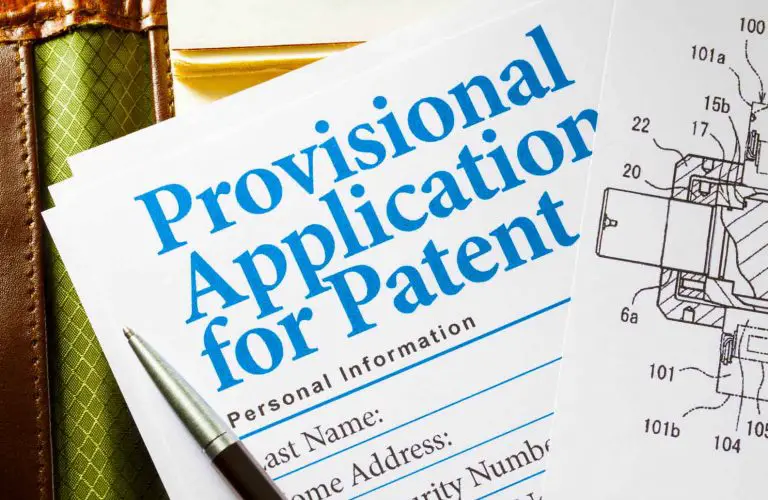Provisional Patent
Provisional Patent (Provisional Patent Application)
A provisional patent, correctly known as a provisional patent application is a type of patent application filed at the USPTO (United States Patent and Trademark Office). Provisional patent applications are filed by inventors with the patent office to obtain an early filing date for their invention. Obtaining an early priority date for an invention is very important in the United States because it uses a first to file system instead of a first to invent system.
In a first to file system, the inventor who first files a patent application (provisional or nonprovisional) gets the patent if the invention meets the patenting requirements. Anyone who submits a patent application to patent the same invention won’t be able to patent it because of the first inventor filing his patent application.
For example, if you invented a new type of engine that provides better fuel economy and someone else invents the same engine 2 years later and file a patent application with the USPTO (United States Patent and Trademark Office) before you do. His invention will get a patent even though you invented the engine first. So, what’s the takeaway?
If you invent something, file a patent application with the patent office to obtain an early priority date. This will stop others from patenting your invention. Going back to our example, had you filed a patent application first, you would have gotten the patent, but because you didn’t file, the other person gets the patent and you won’t be able to patent your invention. This is so because the patented invention would be considered as prior art, prohibiting you from patenting the same invention.
Why Get a Provisional Patent?
Inventors often choose to file a provisional patent application instead of filing a regular, nonprovisional utility patent application because provisional applications are easier and less expensive to prepare, they also cost less to file.
While a regular utility patent application requires formal claims and an information disclosure statement (IDS), a provisional application only requires a description of the invention and some basic information, such as the inventor’s name and address.
While a provisional patent does not require drawings, inventors often choose to include them to describe the invention in more detail. You’ve probably heard the saying that a picture is worth a thousand words, so including drawings of your invention makes your provisional application stronger because it clearly describes the invention that you want to patent.
Having a strong provisional application could prove to be really important in a situation where a party files a patent application for the same invention you filed for. We well explain why in a moment.
As you may or may not be aware, provisional patent applications do not turn into patents unless an inventor converts a provisional application into a nonprovisional application or files a nonprovisional patent application that claims the benefit of an earlier-filed provisional application.
If an inventor has a weak provisional patent application that does not adequately describe his invention, he will not be able to claim the earlier filing date of the provisional patent application. This is so because the patent examiner looks at the description of the provisional patent application and compares it to the description in a later-filed nonprovisional patent application.
The descriptions have to match for an inventor to be able to claim the priority date of an earlier-filed provisional application. If the descriptions don’t match, an inventor will not be able to claim the early filing date of an earlier-filed provisional application.
So, if someone else files a patent application for the same invention after you’ve filed your provisional application but before you filed your regular patent application, the other person will get the patent and you won’t because you can’t claim the earlier filing date of the provisional patent application.
How Much Does it Cost to File a Provisional Patent?
The USPTO charges applicants the following fees:
- Micro entities: $70
- Small entities: $140
- Large entities: $280
If you choose to seek the assistance of an attorney to prepare your provisional patent application, you may need to budget in an additional $1,500 to $3,000 for such assistance. That said, it’s important to note that attorney fees will vary depending on the complexity of your invention and your geographical location. Attorneys in different areas charge different amounts of money to assist inventors with the preparation of their patent applications.
Fortunately, provisional patents don’t require the payment of patent search fees and examinations fees, making provisional patents much less expensive to obtain.
What is the Difference Between a Provisional Patent and a Nonprovisional Patent?
The main difference between a provisional patent application and a nonprovisional utility patent application is that a provisional patent application never becomes a granted patent, whereas a nonprovisional patent application can become a granted patent if the patent office approves the application.
The second difference between the two is that a provisional patent application requires significantly less information than a nonprovisional application. For example, provisional applications do not require formal patent claims. That said, a provisional application should include a thorough description of the invention to be patented.
The third difference is that a provisional application does not require an information disclosure statement (IDS). An information disclosure statement contains information about inventions that are similar or relate to the invention that the inventor is trying to patent.
The fourth difference is that a provisional application does not require an oath or declaration. A patent oath or declaration form requires the applicant to declare that he is the first and original inventor of the invention to be patented. It also requires information, such as the name of the inventor, his residence, and mailing address. Application for provisional patent applicants are not required to complete and submit the declaration form.
What Are the Benefits of a Provisional Patent?
- The main benefit of filing a provisional patent application is that it reserves an early filing date. Reserving an early filing date is very important in the United States because of the first to file rule that awards inventors who first file a patent application with the patent office.
- The second benefit of filing a provisional application is that it costs inventors significantly less to file a provisional application than filing a regular utility patent application. That said, it’s important to note that applicants should spend the time to thoroughly describe an invention in a provisional patent application to avoid problems patenting their invention down the road.
- The third benefit of a provisional patent application is that an inventor will be able to market his invention as patent-pending as soon as he files a provisional application with the patent office. Using the designation “patent pending” is a good marketing tool for an inventor’s product. Also, using the designation tells infringers to stay away from your invention because you’ve taken legal steps to protect it.
- The fourth benefit of a provisional patent application is that it offers inventors an extra year of patent protection. How does it do this? If an inventor files a nonprovisional patent application within 12 months of filing a provisional application, the patent term starts at the filing of the nonprovisional application and the protection starts at the time of filing the provisional application, giving an inventor an extra year of protection.
Does a Provisional Patent Protect You?
As we mentioned earlier, a provisional patent application, commonly known as a provisional patent, is not a granted patent, as such it does not provide legal protection. That is, a filer of a provisional patent application does not give the right to an inventor to stop others from using, making, and selling the patented invention.
Said differently, an inventor who has filed a provisional patent application, cannot sue anyone who copies, makes, sells, or uses his patent-pending invention.
If the patent office approves or grants an inventor’s patent application, only then can the inventor enforce his rights under patent law to restrict others from using, making, selling, and importing the patented invention to the United States.
So, if someone copies or sells an inventor’s invention after the patent office has granted the inventor a patent, the inventor will be able to sue that party for patent infringement in federal court. If the patent holder is successful, he may obtain a court order ordering the infringer to stop his infringing activities.
Can you Sell a Provisional Patent?
Yes, you can sell a provisional patent. A person who sells a provisional patent can transfer ownership of the provisional patent application by executing an assignment agreement that transfers the patent from the transferor to the transferee. The transferor is the person who’s giving up his rights under the patent and the transferee is the party receiving the provisional patent rights.
Once the parties execute an assignment agreement, the agreement must be recorded with the patent office for the record to show the change of ownership. An assignment does not go into effect until it is recorded at the USPTO. Once an assignment is performed, it cannot be undone.
Holders of provisional patent applications often choose to license them to third parties. Licensing a provisional patent allows the applicant to retain ownership over the patented invention while allowing third parties to use the patent-pending invention.
How Long Does a Provisional Patent Last For?
A provisional patent lasts for 12 months from the filing date of a provisional patent application. To obtain a patent, an inventor has 12 months to file a nonprovisional patent application or convert a provisional patent application into a nonprovisional patent application.
The patent office rarely grants extensions for provisional patents, so make sure to convert your provisional application or file a nonprovisional patent application within the 12 month grace period.
If an inventor does not convert his application or file a regular application within the 12 month grace period, the provisional application will be deemed to have been abandoned and the applicant loses his early filing date.
That said, an inventor can still file a subsequent provisional or nonprovisional patent application for the same invention, but he will not be able to benefit from the early filing date of the initial provisional patent application.
Can You License a Provisional Patent?
Yes, a provisional patent application can be licensed to a third party. A holder of a provisional patent application can license his patent-pending invention to a third party to use. The scope of use depends on the agreement that the parties execute.
Applicants often license the use of their patent-pending invention to others in exchange for an agreed-upon fee, commonly known as a licensing fee or royalty. That said, determining how much a license for a provisional application is difficult to determine due to the fact that provisional applications are not published. This creates uncertainty as to what the invention is, as well as the scope of its protection.
What Happens if a Provisional Patent Expires?
If a provisional patent expires, the provisional patent application is deemed to have been abandoned and the applicant loses the early filing date established by the provisional application.
This becomes a problem in the situation where another party files a patent application for the same invention after you filed your provisional application. This is so because once your provisional patent expires, the party that filed its application after you filed your provisional patent application has priority over you because of the first to file rule in the United States.
So, if you try to file another provisional application after another party filed a patent application for the same invention, you won’t be able to patent your invention because the person who filed after you now has priority over your invention. So, what should you take away? Don’t let your provisional patent application expire and file your nonprovisional application before the expiration of the 12 month grace period.
Do You Need a Lawyer to File a Provisional Patent?
Although applicants don’t need a lawyer to file a provisional patent application, the USPTO recommends that applicants hire an attorney to assist them with the preparation of a patent application. This is so because patent law is quite complex and making even seemingly minor mistakes could cause big problems down the road.
So, if you want to obtain a provisional patent consider hiring an attorney to assist you with the application. That said, if you cannot afford to hire an attorney, you should consider the option of hiring a patent agent. Patent agents like patent attorneys, are licensed by the patent office and are allowed to represent inventors in preparing, filing, and prosecuting patent applications. Since patent agents are not attorneys, they often charge less for their services.
How do You Get a Provisional Patent?
An inventor can get a provisional patent by heading over to the USPTO website, preparing a provisional application, and submitting the application online. We have an awesome and complete guide here. To get a provisional patent, an applicant will have to provide basic information, such as the name of the inventor, his residence, mailing address, description of the invention, as well as a specification sheet, and invention drawings if they’re necessary to assist the patent examiner in understanding the invention you want to protect.
What Information Should You Include In a Provisional Patent Application?
A provisional patent application should include the following information:
- Title of the invention
- Name(s) of inventor(s)
- Residence address for inventor(s)
- Correspondence address
- A written description of the invention
- Drawings of your invention
- Applicable filing fee
Should You Get a Provisional Patent?
You should get a provisional patent if you want to quickly obtain an early filing date for your invention. For example, if you’re in a competitive field and you have an invention that you haven’t quite finished working on, you can file a provisional patent application to reserve an early filing date while you continue working on your invention.
If you want to share your invention with the public, it’s a good idea to file a provisional application to protect your invention. Remember that the U.S is a first to file system, so if you disclose your invention before filing a patent application, a third party may steal your invention and file a patent application before you do. So, file a provisional patent application to protect your invention before you disclose it to the public.
If you file a provisional application, just remember that to obtain a patent, you will have to file a nonprovisional patent application within 12 months of filing your provisional application. If you don’t file a regular, nonprovisional patent application within the 12 month grace period, your provisional application will be abandoned and you’ll lose your early filing date.
When Should You File a Provisional Patent Application?
You should file a provisional patent application once you can explain how to make your invention and how to use it. Some inventors often wait to file their provisional patent application so that they can delay the clock starting on the provisional patent. However, if you want to share your invention with the public or offer it for sale, it’s recommended that you file a patent application to obtain a filing date for your invention.
That said, we have to remind you that if you publicly disclosed your invention, offered it for sale, or sold it, you have 12 months to file your provisional application with the patent office. If you do not file your provisional patent application within the 12 month grace period, you will not be able to patent your invention because it will be considered as prior art that prohibits you from patenting your invention.
Do Provisional Patent Applications Require Drawings?
Drawings are not required for provisional patent applications, however, including drawings will help explain your invention to the patent examiner. Drawings can fill in any gaps that you left while describing your invention.
So, while not necessary, you should always try to include them because they will make your provisional patent application stronger. Having a strong provisional patent makes it easier for a later-filed nonprovisional patent application to relate back to and benefit from the earlier filing date of the provisional application.
If you want to include drawings but don’t know how to create them, don’t worry, you’re not alone. Just do a quick google search for patent drawings services and you’ll find a ton of options to choose from. These services often cost anywhere between $50 to $100 per drawings, so if you want to include 7 drawings, expect to pay anywhere from $350 to $700 for professionally created drawings.
How Long Does it Take to Get a Provisional Patent?
As we stated previously, there is no such thing as a provisional patent. People often refer to a provisional patent application as a provisional patent. So, if you want to “get a provisional patent” all you need to is prepare and file a provisional patent application with the patent office. Once you submit your provisional patent application, you can immediately use the term “patent pending” on your products. So, basically, you get it as soon as you file the provisional application. Just remember, provisional applications do not turn into patents.
How To Turn a Provisional Patent Into a Nonprovisional Patent Application?
An applicant can turn a provisional patent into a nonprovisional patent application in two ways. The first method we will discuss is rarely used but it’s still an option and this is to convert a provisional patent application into a nonprovisional application. This is done by filing a petition to convert the provisional application. This method is rarely used because applicants lose a year of patent protection since the patent term begins at the time of filing the provisional patent application.
The second and most used method is to file a nonprovisional, regular utility patent application that claims the earlier filing date of the provisional patent application. If an applicant chooses this route, the patent term begins at the time of filing the nonprovisional patent application, so you effectively have patent protection that lasts for 21 years, since protection starts at the time of filing the provisional application.
To be able to claim the earlier filing date of the provisional application, the invention described in the nonprovisional application must match the description of the invention the inventor provided in the provisional application. This is why we stress the fact that an inventor should take the time to thoroughly describe the invention in the provisional application.
If the patent examiner determines that the invention descriptions don’t match, the inventor will not be able to claim the earlier filing date of the provisional application.
Frequently Asked Questions
1) Can you file a provisional patent on your own?
Yes, an inventor is allowed to prepare and file a provisional patent application with the USPTO on his own, he does not need to be represented by an attorney. That said, the patent office recommends that inventors hire a patent attorney to assist them with the preparation and filing of a provisional patent application.
2) Does a provisional patent application become a patent?
A provisional patent application can never become a patent. For an inventor to patent his invention, he must either convert his provisional application into a nonprovisional application or file a nonprovisional application that relates back to an earlier-filed provisional application.
3) Can you extend the life of your provisional application?
Generally, an applicant is not permitted to extend the life of his provisional patent. The patent office only extends them in very rare circumstances, so you shouldn’t rely on obtaining an extension. If you file a provisional application, make sure that you file a nonprovisional application that claims the benefits of an earlier provisional application within the 12 month grace period.
4) Should you spend time preparing a provisional patent application?
Absolutely yes! You should describe your invention as thoroughly as possible, especially if you’re going to publicly disclose it or offer it for sale. This is so because if someone else files a patent application after you filed your provisional application, your provisional application must be strong so that you can benefit from the earlier filing date. If your provisional application is poorly drafted, it’s useless when the time comes to file a regular, nonprovisional patent application.
5) Why do people use provisional patent applications?
Inventors are often in a rush to obtain an early filing date because of the first to file rule in the U.S. So, once they can describe how to make the invention and how to use it, they choose to file a provisional application to reserve an early filing date. This prevents others from patenting the invention before an applicant gets to do so.
6) Is it expensive to get a provisional patent?
Filing a provisional patent application with the patent office is a fairly inexpensive process, you simply pay a filing fee that does not exceed $280, you submit a description of the invention, as well as basic information, such as the name of the inventor, the address of his residence, and a correspondence address and you’re done. Filing a provisional patent application is much easier and less expensive than submitting a nonprovisional patent application.








